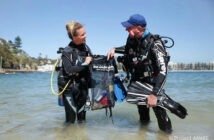The first of seven American merchant ships with that name was the SS Samuel Mather. After being rammed by the steel freighter Brazil in dense fog in Whitefish Bay, eight miles (13 kilometres) from Point Iroquois, the wooden Mather sank in 1891, ending a four-year career. Her intact wreck is a unique illustration of the wooden freighters that plied the Great Lakes, and she is a well-liked scuba diving location. No lives were lost with her sinking.
After being launched in Cleveland for her initial owners, R. John W. Moore, et al., on April 7, 1887, The Mather experienced a number of mishaps and ownership changes. On October 20, 1887, the tug Mystic tow her to Sault Ste. Marie, Michigan with broken machinery as she made her way from Sandusky, Ohio to Duluth, Minnesota. She was sold to Samuel Mather, et al. of Cleveland, Ohio, on May 9th, 1888. She was harmed by a strong gale on August 11th, 1888, near Detour, Michigan, and later repaired in Cleveland. She was sold to James Pickard, et al. of the Interlake Transportation Company on April 13, 1889. She towed the Senator and the Winana in June 1889. She was defamed for sinking the steamer Ohio on September 30, 1890. A steamer that transported coal, the Mather “perished with an abnormal cargo of wheat.”
The wooden Mather was rammed on the starboard side near the aft hatch by the steel package freighter Brazil on November 22, 1891, at 2:00 am while she was headed down from Duluth, Minnesota to Buffalo, New York with a load of 58,000 bushels of wheat. This incident occurred in Whitefish Bay, which is located 8 miles (13 km) north of Point Iroquois, during a dense, heavy fog. On her starboard side, the collision left an 11-foot (3.4 m) hole. The crew of twenty sustained no casualties. Her crew managed to escape with her lifeboats during the 25 minutes she was at sea, but they were left without any personal belongings. The Brazil picked up the crew, who were then moved to the steamer Parks Foster to be taken to Sault Ste. Marie, Michigan. The Brazil continued on to Duluth with her load of coal, where it was discovered that the collision had broken three frames and a stringer. The Mather was worth $50,000, and when combined with her wheat cargo, the loss was estimated to be over $226,000.
Bob Smith of Sault Ste. Marie, Michigan made the discovery of the Mather’s wreck in May 1978, and the Great Lakes Shipwreck Historical Society (GLSHS) has produced a substantial amount of film about it. The Mather’s artifacts were taken by the Great Lakes Shipwreck Historical Society for preservation and display in the Great Lakes Shipwreck Museum, according to shipwreck historian Janice Gerred. The 1980 Michigan Antiquities Act, however, made it illegal to take items from shipwrecks on Great Lakes bottomlands. The Great Lakes Shipwreck Museum and GLSHS offices were raided by the Michigan Department of Natural Resources and Environment in 1992, and among the items seized were some that had been forcibly removed from the Samuel Mather in the 1980s. As a result of a 1993 settlement agreement with the GLSHS following the DNR raid on the museum in 1992, artifacts from the Mather’s wreck are on display in the Great Lakes Shipwreck Museum as a loan from the State of Michigan. The Whitefish Point Underwater Preserve has begun to protect the Samuel Mather’s wreck as part of an underwater museum.

According to Stonehouse, the Mather’s wreck is “one of the best known examples of a wooden freighter that is still available for examination.”The Mather, which sits upright with an intact deck and a largely intact stern superstructure, is a well-liked wreck site for scuba diving. She is in excellent condition overall, probably because she sank gradually enough for pressures to equalize. She has a mast that is 75 feet high, a deck that is 155 feet high, and a bottom that is 180 feet deep.
Despite not being the deepest dive in the Whitefish Point Underwater Preserve, the Mather claimed the lives of three scuba divers: one in 1998, one in 1999, and one in 2012, despite not being the deepest dive.
Harrington, a Great Lakes diver, issues this warning: “Divers must be certain of their abilities and equipment” when diving the Whitefish Point Underwater Preserve.








